Large oil leak after replacing exhaust camshaft (cvvt) seal - help needed!
#1
Hi
2005 Volvo XC90 T5 (135,000 mi), developed an oil leak a few months ago, on the passenger side. Upon inspection, looks to be coming from the timing belt cover, up around the camshafts.
I did some reading, sounded like the PCV system may be clogged up and building up pressure in the crankcase. The glove test proved it - it was inflating. I serviced the PCV system, replaced the oil trap (it wasn't clogged), etc. The main issue was the tiny hose from the intake pcv valve - it was clogged and broken. Cleaned the valve, replaced the hose, glove test showed small amount of vacuum in the crank case at idle. Drove the car with a vacuum gauge connected to the dipstick - small vacuum at idle, then also under boost/acceleration. PCV system seems to be working fine.
Today I decided to tackle the oil leak, suspected from the exhaust camshaft seal, timing belt side. I read up on the procedure, fabricated a cam locking tool, marked everything up as per the various write ups. I also have VIDA to reference... Took off the exhaust CVVT hub, the seal behind it was slightly pushed out (not flush with the champhered edge. Replaced it, put the CVVT hub back on, torqued everything as needed, etc. Put everything back, started the motor, and then..
Started up fine, ran as normal. I walked to the front to look at the timing belt (the cover was still off), and noticed a large puddle of oil under the car! Quickly turned the car off.
Upon inspection, in about 20 seconds of idling, the engine had managed to eject about half of the engine oil. The inside of the timing belt cover was all wet again (after I had cleaned and dried it). The oil leak *seems* to be from either the exhaust camshaft seal (which I had just replaced), or from the CVVT hub itself.
Unlike what I had before - this was NOT a slow leak. If I had not turned the engine off, I would have most likely ejected all the oil, and seized. I caught it when the oil level was 'just' at the bottom of the dipstick marked range.
I pulled the exhaust cvvt hub off again, expecting to see the cam seal be pushed out due to pressure - but it was perfectly seated in it's place!
So, I am at a loss. I have no idea what I could have done to cause this.
- I locked the cams, marked the timing gears
- Torqued everything as per spec, including center cvvt hub bolt, and the cap.
- Timing marks aligned fine when I put the timing belt back on
- Engine ran fine when started, no CEL, no indication of anything wrong, other than the rapid discharge of engine oil from around the exhaust cvvt area.
Anyone have any ideas as to what is going on?
So, some questions, any help is GREATLY appreciated:
If I had gotten the timing wrong, the engine wouldn't run, plus surely there is nothing about timing that would cause oil to pour out of the motor?
If the cvvt hub is leaking, could I have caused that somehow? I have not dropped it or anything like that. I took it off, wiped it clean, put it back on. Everything torqued as per the manual... Is it even possible for multiple quarts of oil to be discharged via the cvvt hub in under half a minute?
If the seal is leaking - why? I compared it to the one that came out, the sizes were the same, and even the various serials numbers, dimesions, etc on the seal were the same. It fit perfectly fine around the cvvt seal mating area, it wasn't loose, it wasn't overly tight.
How does the oil flow work with the cvvt hubs? Based on my reading, it seems to reverse direction based on the control valve above - either coming in (or back out) via the center channel in the camshaft. Is there anything I could have mis-aligned to cause some of those passages to be blocked, and the oil be forced out via the oil seal, or the hub itself? If the cvvt hub is on wrong, could it cause oil leakage?
Finally, just to double check my cvvt alignment - what is the process of aligning assuming that there are NO marks made during dis-assembly? IE, what does one one when they install a new head, new cams, etc? I cannot for the life of me find that in VIDA. I do have the cam locking tool, which can lock the cams with the notches on the rear side horizontal and parallel with the cylinder head surface. That's about it, assuming there is nothing else marked up - what can one do to try to time the engine? Alternatively, given that the engine ran fine and there was no CEL thrown - can I be confident that my cvvt alignment was successful, and the issue is something entirely else?
Again, I am totally lost on this one, so any and all ideas and help is appreciated.
cheers,
Jordan
ps> some pics below:
Before I took off the cvvt hubs:
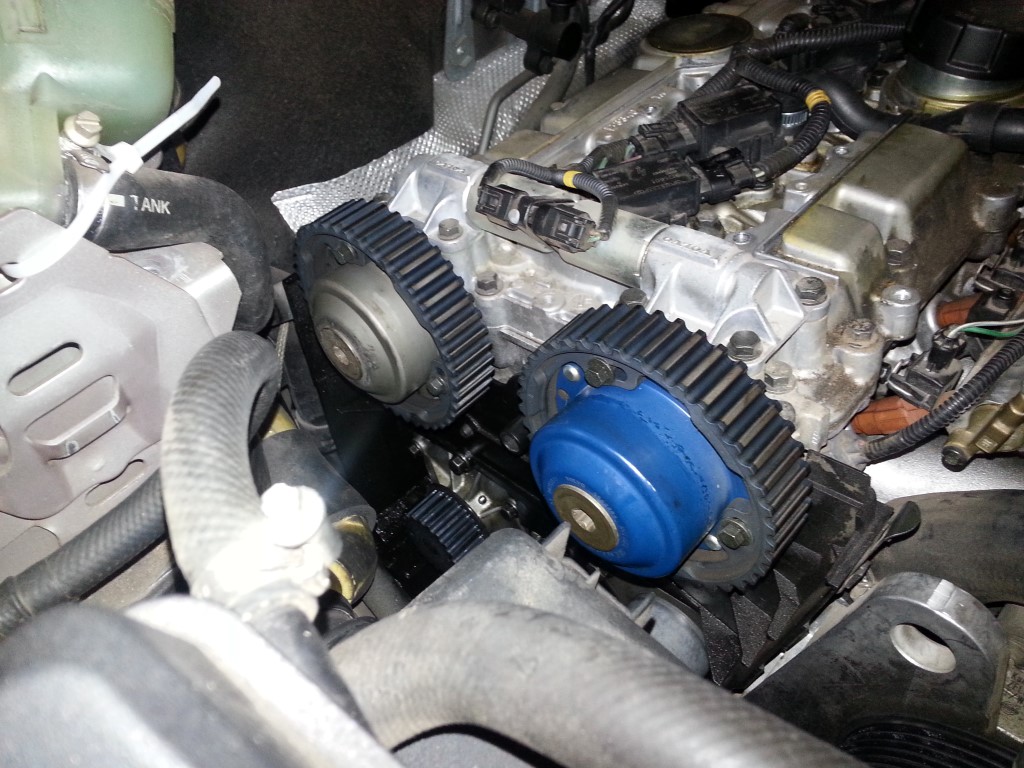
After the big oil leak, second removal of exhaust cvvt hub. Oil seal was perfectly in place and seated:
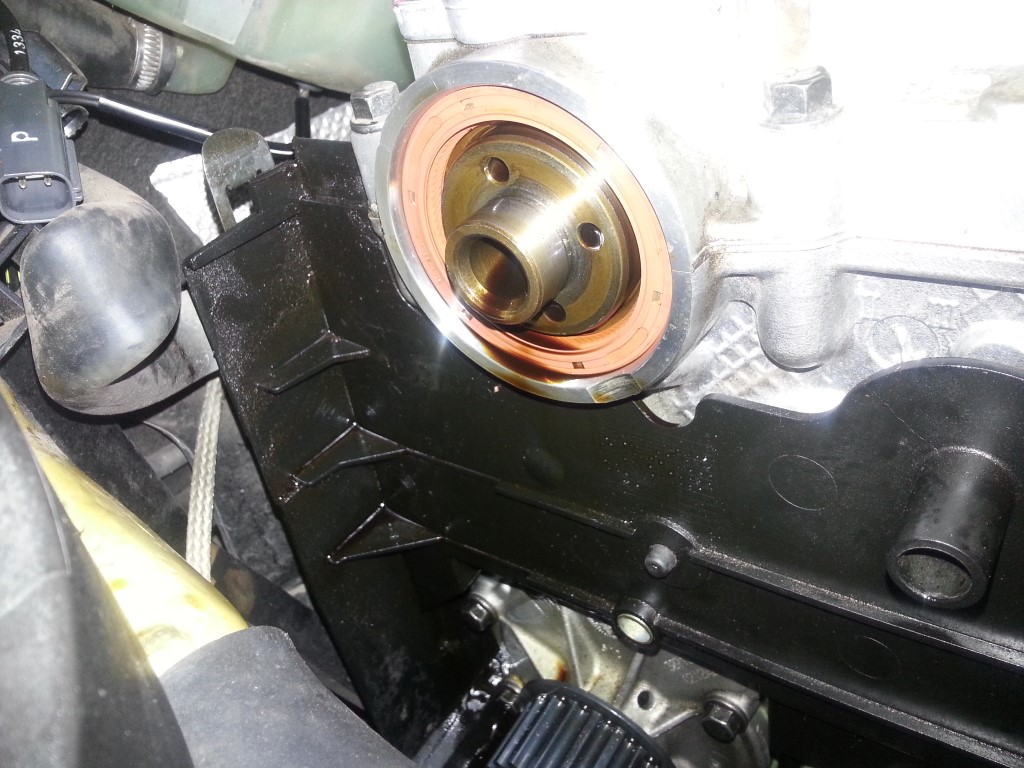
The exhaust cvvt hub itself, rear side. Adding due to various posts about a pressure relief piston and o-ring that may leak, but I don't see anything similar on mine:
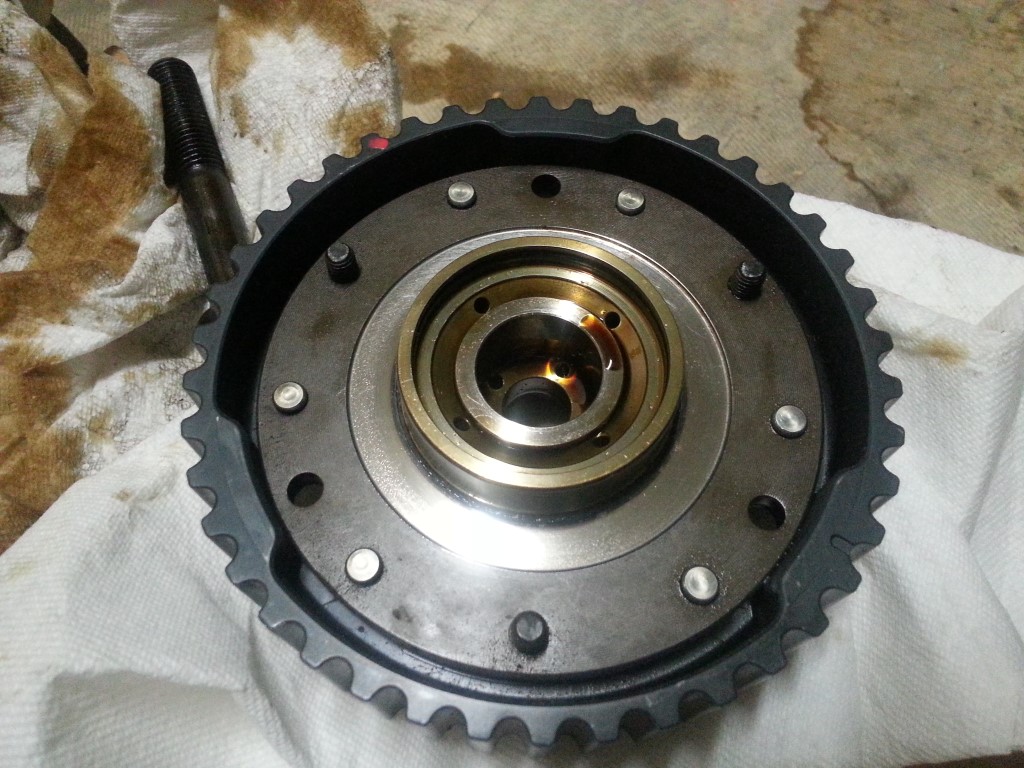
2005 Volvo XC90 T5 (135,000 mi), developed an oil leak a few months ago, on the passenger side. Upon inspection, looks to be coming from the timing belt cover, up around the camshafts.
I did some reading, sounded like the PCV system may be clogged up and building up pressure in the crankcase. The glove test proved it - it was inflating. I serviced the PCV system, replaced the oil trap (it wasn't clogged), etc. The main issue was the tiny hose from the intake pcv valve - it was clogged and broken. Cleaned the valve, replaced the hose, glove test showed small amount of vacuum in the crank case at idle. Drove the car with a vacuum gauge connected to the dipstick - small vacuum at idle, then also under boost/acceleration. PCV system seems to be working fine.
Today I decided to tackle the oil leak, suspected from the exhaust camshaft seal, timing belt side. I read up on the procedure, fabricated a cam locking tool, marked everything up as per the various write ups. I also have VIDA to reference... Took off the exhaust CVVT hub, the seal behind it was slightly pushed out (not flush with the champhered edge. Replaced it, put the CVVT hub back on, torqued everything as needed, etc. Put everything back, started the motor, and then..
Started up fine, ran as normal. I walked to the front to look at the timing belt (the cover was still off), and noticed a large puddle of oil under the car! Quickly turned the car off.
Upon inspection, in about 20 seconds of idling, the engine had managed to eject about half of the engine oil. The inside of the timing belt cover was all wet again (after I had cleaned and dried it). The oil leak *seems* to be from either the exhaust camshaft seal (which I had just replaced), or from the CVVT hub itself.
Unlike what I had before - this was NOT a slow leak. If I had not turned the engine off, I would have most likely ejected all the oil, and seized. I caught it when the oil level was 'just' at the bottom of the dipstick marked range.
I pulled the exhaust cvvt hub off again, expecting to see the cam seal be pushed out due to pressure - but it was perfectly seated in it's place!
So, I am at a loss. I have no idea what I could have done to cause this.
- I locked the cams, marked the timing gears
- Torqued everything as per spec, including center cvvt hub bolt, and the cap.
- Timing marks aligned fine when I put the timing belt back on
- Engine ran fine when started, no CEL, no indication of anything wrong, other than the rapid discharge of engine oil from around the exhaust cvvt area.
Anyone have any ideas as to what is going on?
So, some questions, any help is GREATLY appreciated:
If I had gotten the timing wrong, the engine wouldn't run, plus surely there is nothing about timing that would cause oil to pour out of the motor?
If the cvvt hub is leaking, could I have caused that somehow? I have not dropped it or anything like that. I took it off, wiped it clean, put it back on. Everything torqued as per the manual... Is it even possible for multiple quarts of oil to be discharged via the cvvt hub in under half a minute?
If the seal is leaking - why? I compared it to the one that came out, the sizes were the same, and even the various serials numbers, dimesions, etc on the seal were the same. It fit perfectly fine around the cvvt seal mating area, it wasn't loose, it wasn't overly tight.
How does the oil flow work with the cvvt hubs? Based on my reading, it seems to reverse direction based on the control valve above - either coming in (or back out) via the center channel in the camshaft. Is there anything I could have mis-aligned to cause some of those passages to be blocked, and the oil be forced out via the oil seal, or the hub itself? If the cvvt hub is on wrong, could it cause oil leakage?
Finally, just to double check my cvvt alignment - what is the process of aligning assuming that there are NO marks made during dis-assembly? IE, what does one one when they install a new head, new cams, etc? I cannot for the life of me find that in VIDA. I do have the cam locking tool, which can lock the cams with the notches on the rear side horizontal and parallel with the cylinder head surface. That's about it, assuming there is nothing else marked up - what can one do to try to time the engine? Alternatively, given that the engine ran fine and there was no CEL thrown - can I be confident that my cvvt alignment was successful, and the issue is something entirely else?
Again, I am totally lost on this one, so any and all ideas and help is appreciated.
cheers,
Jordan
ps> some pics below:
Before I took off the cvvt hubs:

After the big oil leak, second removal of exhaust cvvt hub. Oil seal was perfectly in place and seated:

The exhaust cvvt hub itself, rear side. Adding due to various posts about a pressure relief piston and o-ring that may leak, but I don't see anything similar on mine:

#2
When I replaced my 1998 S70 GLT Exhaust cam seal, due to the tight space, I bungled up the lip seal (where it mates with the cam shaft).
The lip seal folded inward, can't see until I used the mirror + flash light for a close-up inspection.
You can see detail in the link below:
http://www.matthewsvolvosite.com/for...ic.php?t=53722
So, I replaced the cam seal, taking care not to fold the lip seal during installation. All is well now.
The VVT hub seals: it is difficult to diagnose the VVT leak but usually when this happens, oil gets on the timing belt. In contrast, cam seal leak gets behind the plastic cover and drips down the side of the engine block.
- If in doubt, there is an ebay seller selling only the 2 large O-rings. I don't know much about that seller.
- Another option is new VVT hub from dealer for about ? $150 or so.
The lip seal folded inward, can't see until I used the mirror + flash light for a close-up inspection.
You can see detail in the link below:
http://www.matthewsvolvosite.com/for...ic.php?t=53722
So, I replaced the cam seal, taking care not to fold the lip seal during installation. All is well now.
The VVT hub seals: it is difficult to diagnose the VVT leak but usually when this happens, oil gets on the timing belt. In contrast, cam seal leak gets behind the plastic cover and drips down the side of the engine block.
- If in doubt, there is an ebay seller selling only the 2 large O-rings. I don't know much about that seller.
- Another option is new VVT hub from dealer for about ? $150 or so.
#3
#4
Thanks cn90 and 242.
I think you are both onto something. The leak is almost definitely BEHIND the plastic cover. Some is inside it, but the majority behind. and a little bit is splashed around on the timing belt, but very little on the timing belt itself. Only on the very edge, and closest to the motor side.
The cam seal lip looks great, inspected it with a mirror. However, as per 242's suggestion - I think it is pushed too far in. When I opened it up, the previous seal was basically flush with the casing edge. I thought it was pushed out by crankcase pressure, hence my original slow leak. My replacement was pushed in until it stopped (which is what basically every other seal change I have done in my life advises to do), and ended up about 2-3mm below the edge.
Now, in the pictures below - I can see the wear mark on the VVT hub seal surface (outer ring) is RIGHT on the very edge, maybe 1mm from it. The picture of the hub with the ruler - the inner ring at it's 'highest'. The edge is 3mm higher than the mating surface of the inner ring, which from what I can tell sits flush with the camshaft.
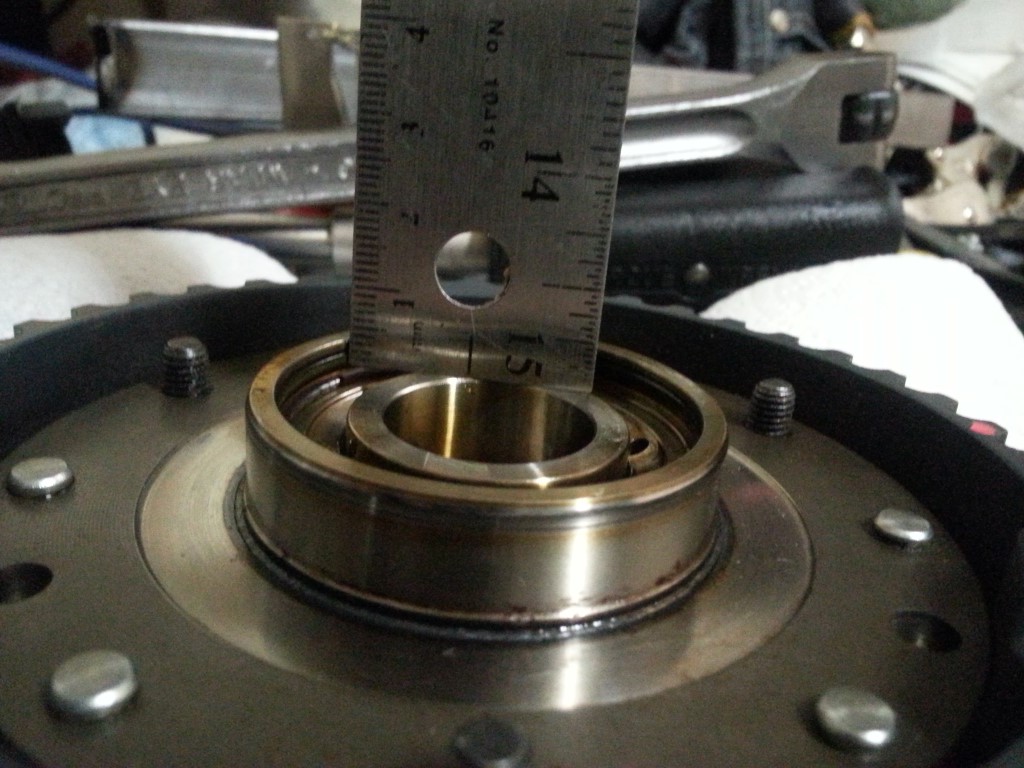
In the picture below of the new seal - you can see it is flush with the cam surface. Meaning, the FRONT edge of the seal is even with the inner ring mating surface (assuming it is at it's 'highest' position). Given that the seal itself is 7mm wide, and the lip that does all the work is on the back side of it - it seems to me that it wouldn't even connect with the surface on the outer ring (when the vvt hub is pushed all the way out) Thoughts?
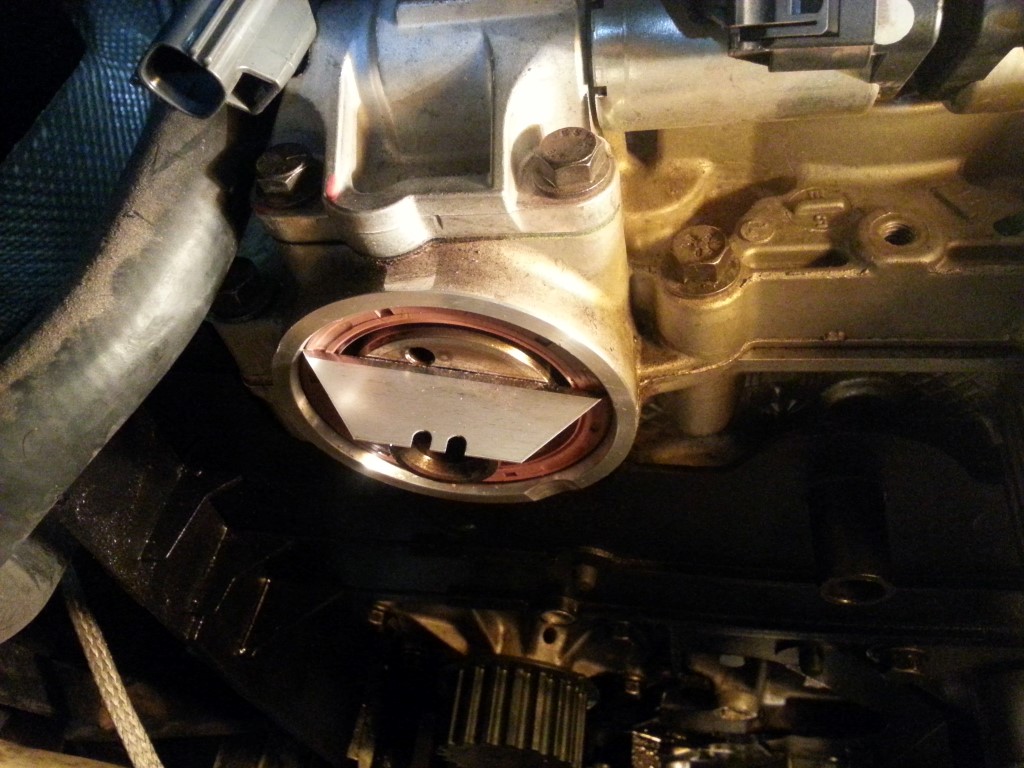
In other words, could it be possible that the seal installation is done in a way where it is NOT pushed all the way in, but sits flush with the outer casing? Meaning that the original seal as I saw it was actually not pushed out by the crankcase pressure, but was simply installed as it should be? This is the first time I would have seen something like that, but that's the only explanation I have. I have checked the seal part number at least 10 times, from FCP, volvopartswarehouse, and NAPA - and they all come up with the same dimensions (part number is 9458309 for both intake and exhaust vvt cams, and those are the numbers on the seals that came out before I replaced them). Also the seal I took out is the same size, is it possible that it was changed previously and the incorrect one was put in? Or, it just doesn't need to be pushed in that far.
I'm going to go over the VIDA instructions again, and search around and check if during installation the seal needs to be pushed in all the way, or not. Time to also order new seal and I'll get the VVT hub o-rings as well.
Thanks for all your help, I appreciate it.
I think you are both onto something. The leak is almost definitely BEHIND the plastic cover. Some is inside it, but the majority behind. and a little bit is splashed around on the timing belt, but very little on the timing belt itself. Only on the very edge, and closest to the motor side.
The cam seal lip looks great, inspected it with a mirror. However, as per 242's suggestion - I think it is pushed too far in. When I opened it up, the previous seal was basically flush with the casing edge. I thought it was pushed out by crankcase pressure, hence my original slow leak. My replacement was pushed in until it stopped (which is what basically every other seal change I have done in my life advises to do), and ended up about 2-3mm below the edge.
Now, in the pictures below - I can see the wear mark on the VVT hub seal surface (outer ring) is RIGHT on the very edge, maybe 1mm from it. The picture of the hub with the ruler - the inner ring at it's 'highest'. The edge is 3mm higher than the mating surface of the inner ring, which from what I can tell sits flush with the camshaft.

In the picture below of the new seal - you can see it is flush with the cam surface. Meaning, the FRONT edge of the seal is even with the inner ring mating surface (assuming it is at it's 'highest' position). Given that the seal itself is 7mm wide, and the lip that does all the work is on the back side of it - it seems to me that it wouldn't even connect with the surface on the outer ring (when the vvt hub is pushed all the way out) Thoughts?

In other words, could it be possible that the seal installation is done in a way where it is NOT pushed all the way in, but sits flush with the outer casing? Meaning that the original seal as I saw it was actually not pushed out by the crankcase pressure, but was simply installed as it should be? This is the first time I would have seen something like that, but that's the only explanation I have. I have checked the seal part number at least 10 times, from FCP, volvopartswarehouse, and NAPA - and they all come up with the same dimensions (part number is 9458309 for both intake and exhaust vvt cams, and those are the numbers on the seals that came out before I replaced them). Also the seal I took out is the same size, is it possible that it was changed previously and the incorrect one was put in? Or, it just doesn't need to be pushed in that far.
I'm going to go over the VIDA instructions again, and search around and check if during installation the seal needs to be pushed in all the way, or not. Time to also order new seal and I'll get the VVT hub o-rings as well.
Thanks for all your help, I appreciate it.
Last edited by jordank; 11-25-2014 at 12:46 AM.
#5
This is a tough one to diagnose. Given that there is a lot of work/labor involved on your part:
1. Cam Seal: can leak (low pressure leak) at where it mates with the cylinder head (arrow #1), or where it mates with the rotating cam shaft (arrow #2).
2. VVT: can leak at the O-rings (arrow #3) but this is high-pressure leak.
IIRC, the VVT solenoid only activates at certain higher rpm (such as > 3000 rpm, someone please confirm this). So if you leak oil at idle, it is unlikely from the VVT seals.
Now if you don't want to redo this job, then you should take care of all these seal, O-rings considering the miles involved. Rubber, nitrile compounds don't last forever.
1. Cam Seal from dealer only, do not use aftermarket brand. And you have one shot at this, make sure you oil the lip before installation to void the lip folding over.
2. The VVT: the only source for the O-rings is ebay.
Otherwise new VVT hub from dealer.

1. Cam Seal: can leak (low pressure leak) at where it mates with the cylinder head (arrow #1), or where it mates with the rotating cam shaft (arrow #2).
2. VVT: can leak at the O-rings (arrow #3) but this is high-pressure leak.
IIRC, the VVT solenoid only activates at certain higher rpm (such as > 3000 rpm, someone please confirm this). So if you leak oil at idle, it is unlikely from the VVT seals.
Now if you don't want to redo this job, then you should take care of all these seal, O-rings considering the miles involved. Rubber, nitrile compounds don't last forever.
1. Cam Seal from dealer only, do not use aftermarket brand. And you have one shot at this, make sure you oil the lip before installation to void the lip folding over.
2. The VVT: the only source for the O-rings is ebay.
Otherwise new VVT hub from dealer.

Last edited by cn90; 11-25-2014 at 08:48 AM.
#6
Thanks cn90.
After more reading, I am now pretty much 100% that the seal should NOT be installed all the way in. VIDA's instructions say 'use drift number XXXX' and based on the drawing of the drift - I think it ensures that it pushes the seal back enough only until the front facing (towards the gear) edge of the seal is flush with the casing of the seat, or maybe a tiny bit further (1mm more?).
Even on the picture you show - you can see that particular seal is seated all the way in - and it's rear edge is not even making full contact on the hub outer ring (at top). How is it supposed to seal oil if it's not even on the side of the outer ring, especially as the VVT hub moves in/out by 3mm during it's normal operation?
I also found this link, which talks in detail about the depth of installation, post #6 in particular.
Lets Talk Cam Seals And How To On A Dual Vvt 5 Cyl - FWD/AWD 1999 - 2010 - Volvospeed Forums
Either way, I have new seals and o-rings on the way (totally agree to replace them all), I'll report back.
cheers,
Jordan
After more reading, I am now pretty much 100% that the seal should NOT be installed all the way in. VIDA's instructions say 'use drift number XXXX' and based on the drawing of the drift - I think it ensures that it pushes the seal back enough only until the front facing (towards the gear) edge of the seal is flush with the casing of the seat, or maybe a tiny bit further (1mm more?).
Even on the picture you show - you can see that particular seal is seated all the way in - and it's rear edge is not even making full contact on the hub outer ring (at top). How is it supposed to seal oil if it's not even on the side of the outer ring, especially as the VVT hub moves in/out by 3mm during it's normal operation?
I also found this link, which talks in detail about the depth of installation, post #6 in particular.
Lets Talk Cam Seals And How To On A Dual Vvt 5 Cyl - FWD/AWD 1999 - 2010 - Volvospeed Forums
Either way, I have new seals and o-rings on the way (totally agree to replace them all), I'll report back.
cheers,
Jordan
#7
We DIYers often take oil seals for granted, but if you look closely at the design (Google "SKF oil seal cutaway"), you will see article like this:
http://www.skf.com/ph/products/seals...als/index.html...
NOTE the terminology:
- "Garter Spring"
- Auxiliary Lip on some seals
The idea is: during installation, oil the lip, rotate it as you go in. Then gently tap the seal in with appropriate adapter while checking the integrity of the lip(s):
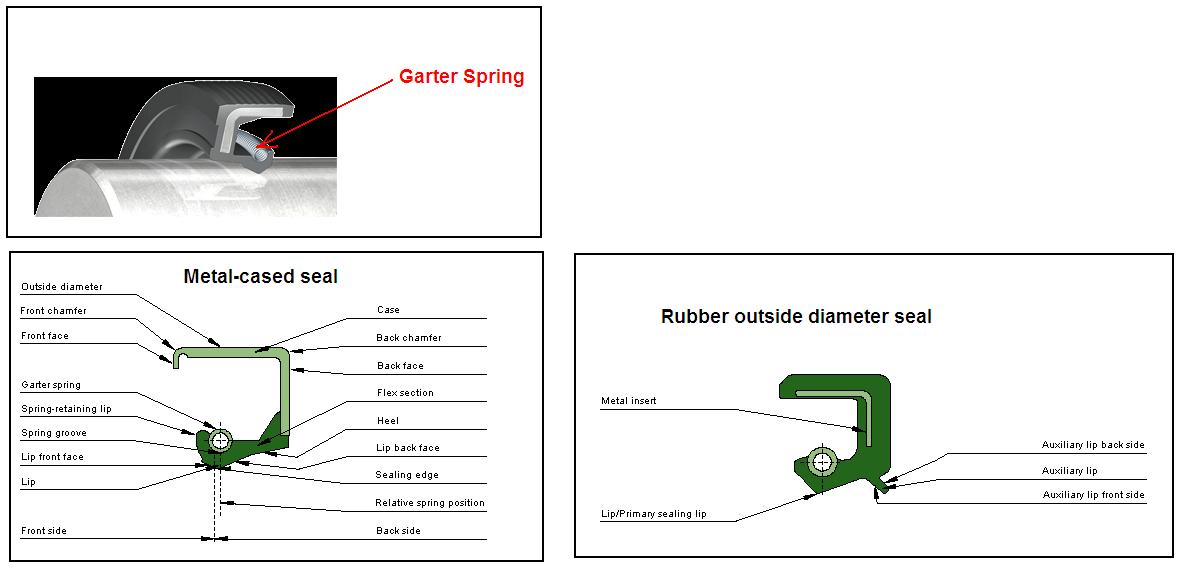
http://www.skf.com/ph/products/seals...als/index.html...
NOTE the terminology:
- "Garter Spring"
- Auxiliary Lip on some seals
The idea is: during installation, oil the lip, rotate it as you go in. Then gently tap the seal in with appropriate adapter while checking the integrity of the lip(s):

#10
The original seals that I took out do have the auxiliary lip, and so do the new ones.
The seal I put in was definitely NOT damaged during the installation, you can see its in perfect shape and identical to the original one in the photos above...
I am 99% convinced that the issue is that it is seated too deep, and the primary lip is not making any contact with the surface on the CVVT hub, when the hub is pushed all the way out (it travels in and out by 3mm or so during normal operation, based on my rough measurements). I will know as soon as my new VVT hub o-rings arrive and I can put it all together again.
If that does end up being the issue, I would personally call that an extremely poor design decision by Volvo. I can understand that those heads and cams are used on both VVT and non-VVT motors, but as a minimum they should be using a different (wider) seal on the VVT cars, which can be inserted until it bottoms out, and still provide the sealing surface necessary on the VVT hub. Alternatively they could use the same seal, but have a spacer than can sit behind it to ensure the correct dept of installation...
The seal I put in was definitely NOT damaged during the installation, you can see its in perfect shape and identical to the original one in the photos above...
I am 99% convinced that the issue is that it is seated too deep, and the primary lip is not making any contact with the surface on the CVVT hub, when the hub is pushed all the way out (it travels in and out by 3mm or so during normal operation, based on my rough measurements). I will know as soon as my new VVT hub o-rings arrive and I can put it all together again.
If that does end up being the issue, I would personally call that an extremely poor design decision by Volvo. I can understand that those heads and cams are used on both VVT and non-VVT motors, but as a minimum they should be using a different (wider) seal on the VVT cars, which can be inserted until it bottoms out, and still provide the sealing surface necessary on the VVT hub. Alternatively they could use the same seal, but have a spacer than can sit behind it to ensure the correct dept of installation...
#12
If you think your cam seal looks good (use a mirror), then I'd leave it alone. Every time you remove the cam seal (be careful, don't nick the mating surface on camshaft!), you risk damaging mating surfaces.
I use sheet metal screws to extract old seal, but I am very careful when doing that. Info in matthews volvo forum.
This thread below mentioned the ebay O-rings ($16 for the pair) and this set of O-rings fixed the VVT Hub leak:
https://volvoforums.com/forum/volvo-...-o-ring-45853/
Now, onto engineering of the VVT Hub. Below is what I think the design is:
- Oil flow: not sure the direction but I label some BLUE arrows anyway. Anyone knows for sure about the directional flow, please chime in.
- RED numbers are where I think the 2 parts (VVT HUB and camshaft) come together.
- The large O-ring (YELLOW arrow) is the main seal the prevents oil from leaking out of the VVT Hub during operation.

I use sheet metal screws to extract old seal, but I am very careful when doing that. Info in matthews volvo forum.
This thread below mentioned the ebay O-rings ($16 for the pair) and this set of O-rings fixed the VVT Hub leak:
https://volvoforums.com/forum/volvo-...-o-ring-45853/
Now, onto engineering of the VVT Hub. Below is what I think the design is:
- Oil flow: not sure the direction but I label some BLUE arrows anyway. Anyone knows for sure about the directional flow, please chime in.
- RED numbers are where I think the 2 parts (VVT HUB and camshaft) come together.
- The large O-ring (YELLOW arrow) is the main seal the prevents oil from leaking out of the VVT Hub during operation.

#13
Food for thoughts...
I don't have the exact diagram of oil flow, but I am thinking this way:
- If you suspect the leak is from the VVT Hub O-rings, then perhaps unplugging the exhaust VVT solenoid will stop oil flow to the VVT? Can someone confirm this fact (that when VVT solenoid is off, there is no oil flow to the VVT Hub)?
This will be a great diagnostic trick if found to be true.
I don't have the exact diagram of oil flow, but I am thinking this way:
- If you suspect the leak is from the VVT Hub O-rings, then perhaps unplugging the exhaust VVT solenoid will stop oil flow to the VVT? Can someone confirm this fact (that when VVT solenoid is off, there is no oil flow to the VVT Hub)?
This will be a great diagnostic trick if found to be true.
#15
I think the O.P. already mentioned he took care of the PCV system in the very 1st post. But it does not hurt when he buttons everything back up, if oil leaks out, then lift the dipstick up a few mm. If the oil leak stops with the dipstick lifted upward, then you have the answer.
On the issue of Seal Anatomy, the sealing effect is accomplished by the "garter spring" squeezing on the lip.
In some other textbooks, Auxiliary Lip = Radial Dirt Lip, basically as the name implies, it keeps dirt out but it does not offer any sealing effect against oil that already leaks out.
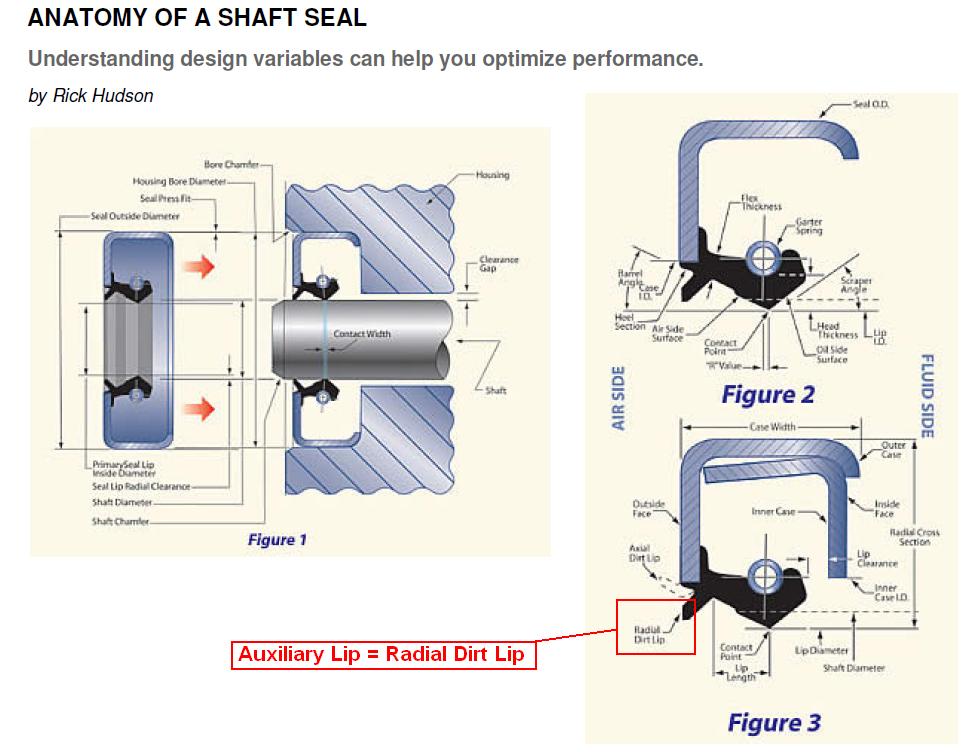
On the issue of Seal Anatomy, the sealing effect is accomplished by the "garter spring" squeezing on the lip.
In some other textbooks, Auxiliary Lip = Radial Dirt Lip, basically as the name implies, it keeps dirt out but it does not offer any sealing effect against oil that already leaks out.

#16
Update...
New parts (two new seals, and the cvvt o-ring sets from ebay) arrived today.
I put it all together. As expected, I had put in the seals too deep when I did them first. When looking at the seal seat, the aluminium is colored differently where it has not been in contact with a seal, it has brown oil deposits. So, the seals do NOT go all the way in.
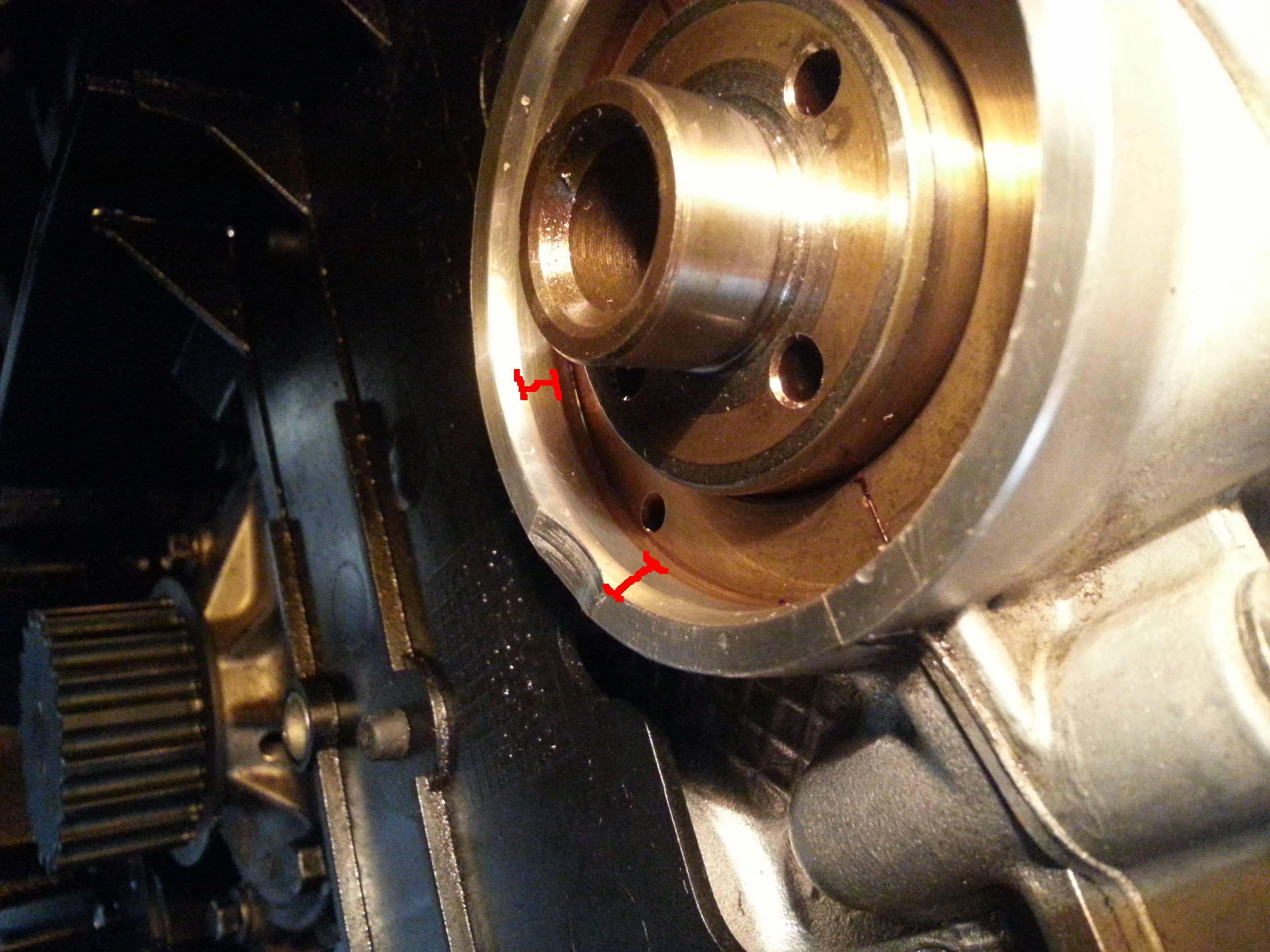
Car ran fine when I started it up (after turning the engine over by hand a few times, just in case), but soon after the CEL came on. I plugged VIDA in, and it indicated that the timing on the intake cam was 'low', meaning 'behind the crankshaft'. I must have not gotten the marks perfect when I installed the intake, for whatever reason. The good news is that I was able to compensate and adjust by loosening the 3 bolts that hold the CVVT hub to the timing gear. From the factory, the bolts were WAY over to one side of the oval holes, and I needed to bring the cam 'forward' so it catches up with the crank (as per the VIDA description), so I moved it a little, the bolts ended up basically in the middle of the oval holes. Cleared the code, no more CEL. Test drive was fine, no issues. Tested the PCV one more time just in case - vacuum in the crank case both at idle, and under boost.
Now, for the bad news. The slow leak does NOT seem to have been resolved. I had wiped everything clean, and then after I had run the engine for a while - there was new oil inside the timing cover. There appears to be a tiny amount on the timing gears themselves, though I can't be 100% certain. There is definitely new oil inside the rear timing cover, and in particular - it seems to collect on a little ledge right below the water pump. It collects in the areas highlighted in the following photos:
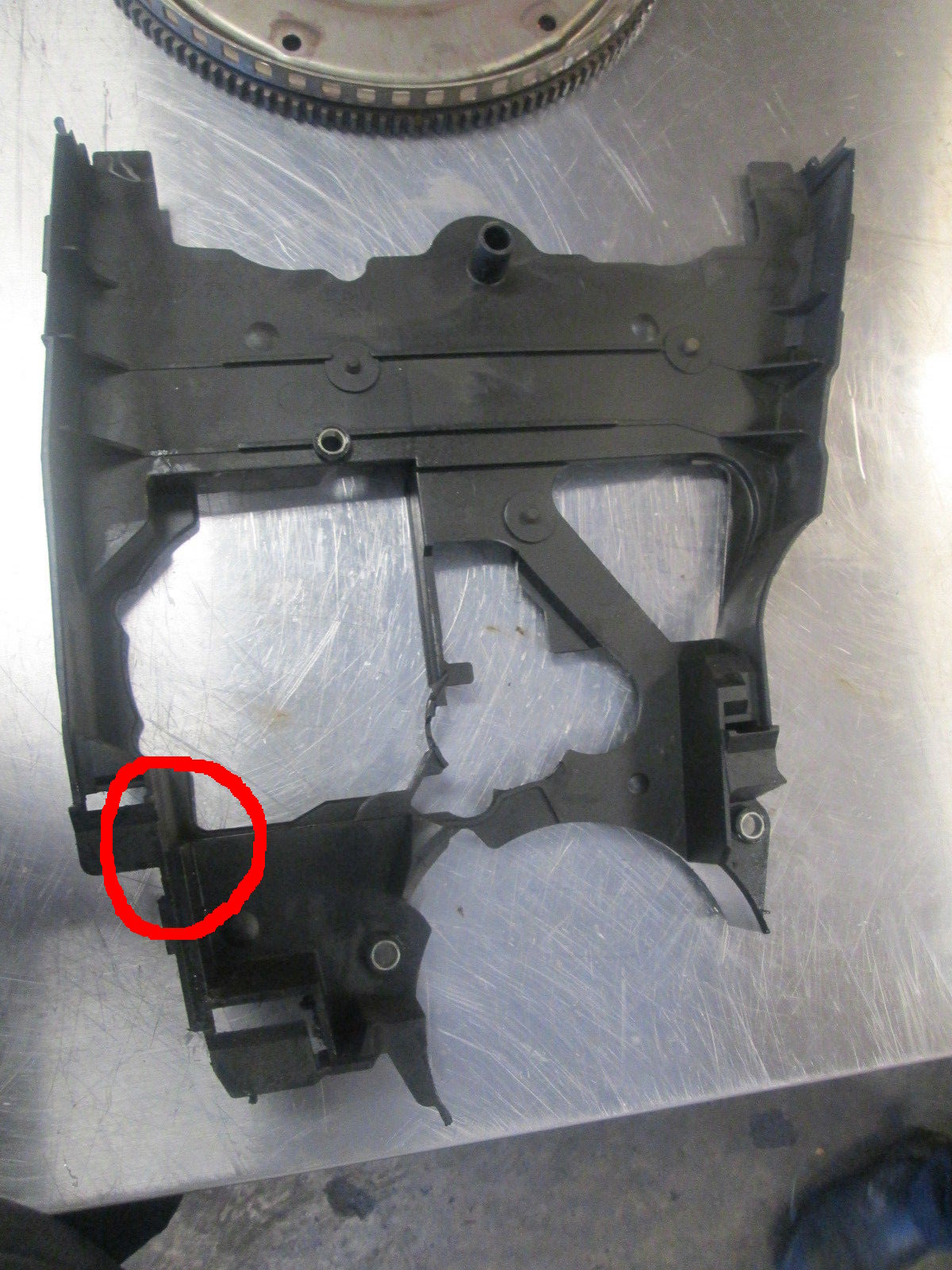
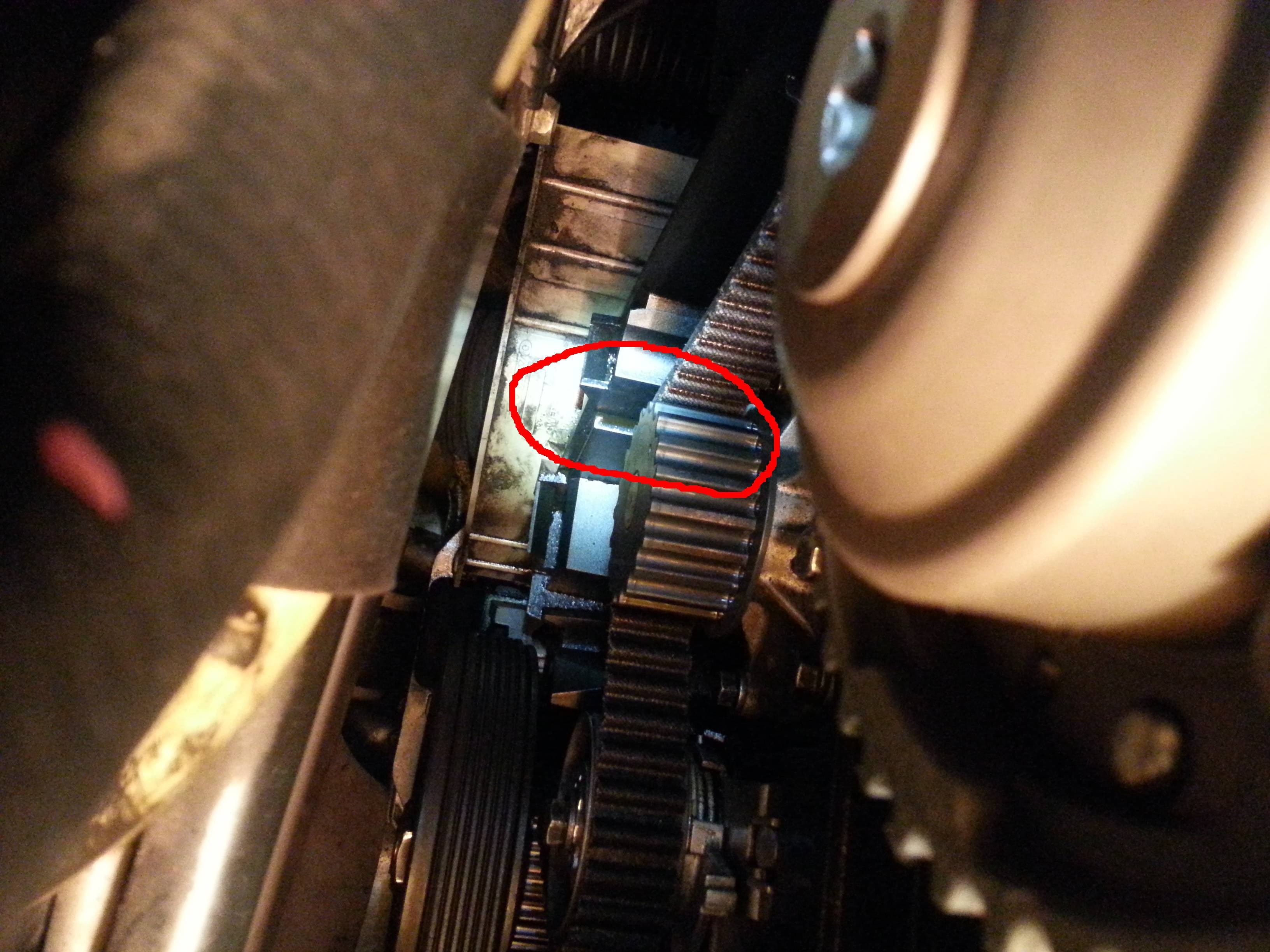
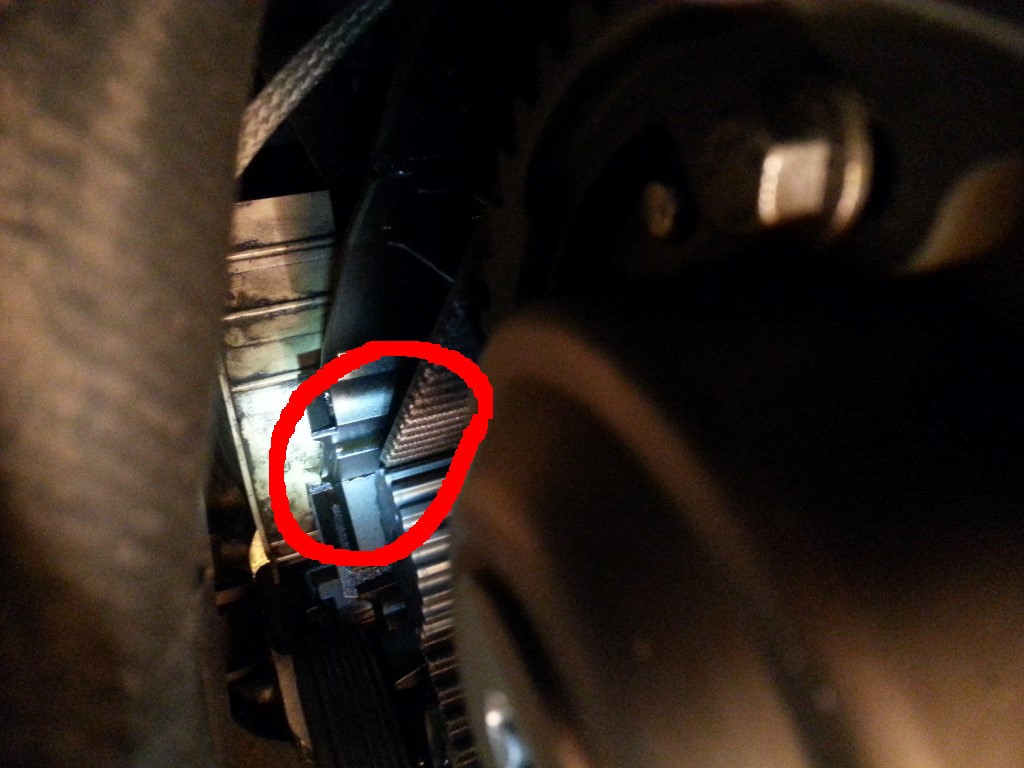
The water pump itself has some on it too, I had wiped it clean too.
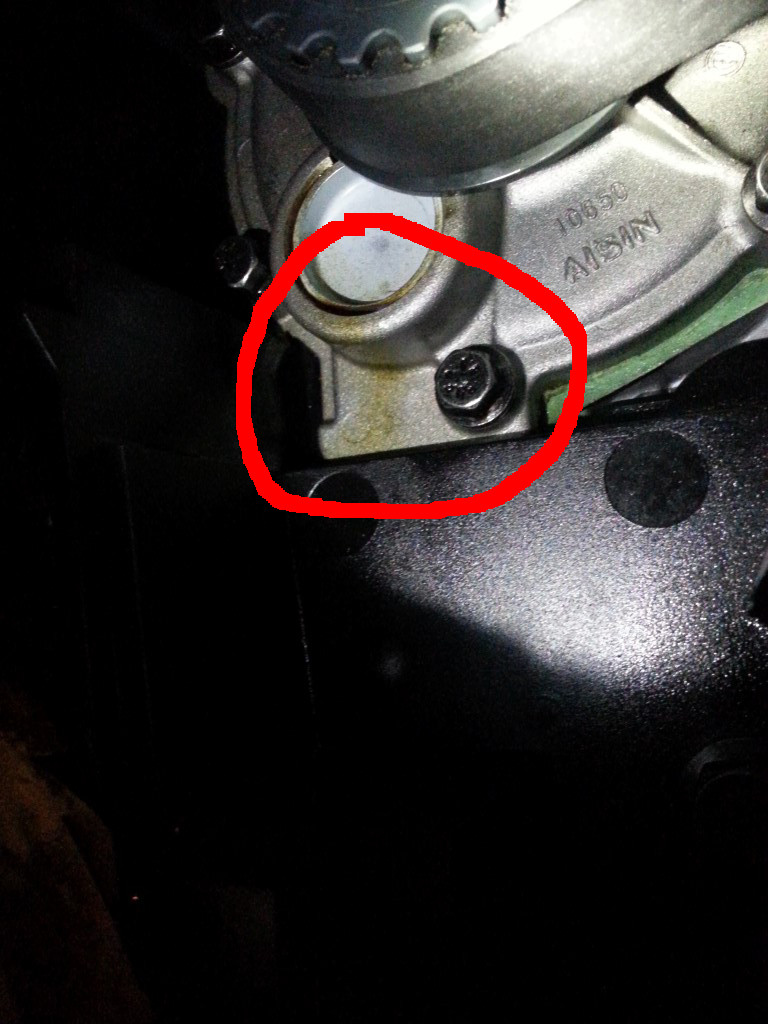
Photo of my old water pump before the timing belt and water pump replacement, for reference:
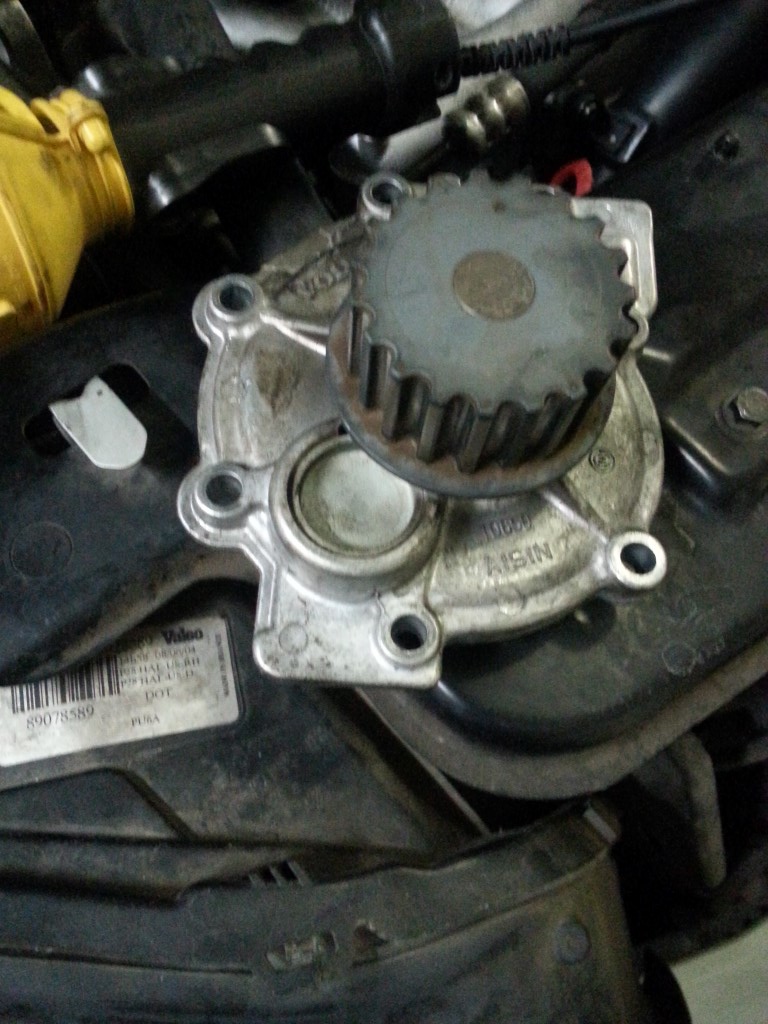
A few more photos of the top camshaft area, from the firewall side:
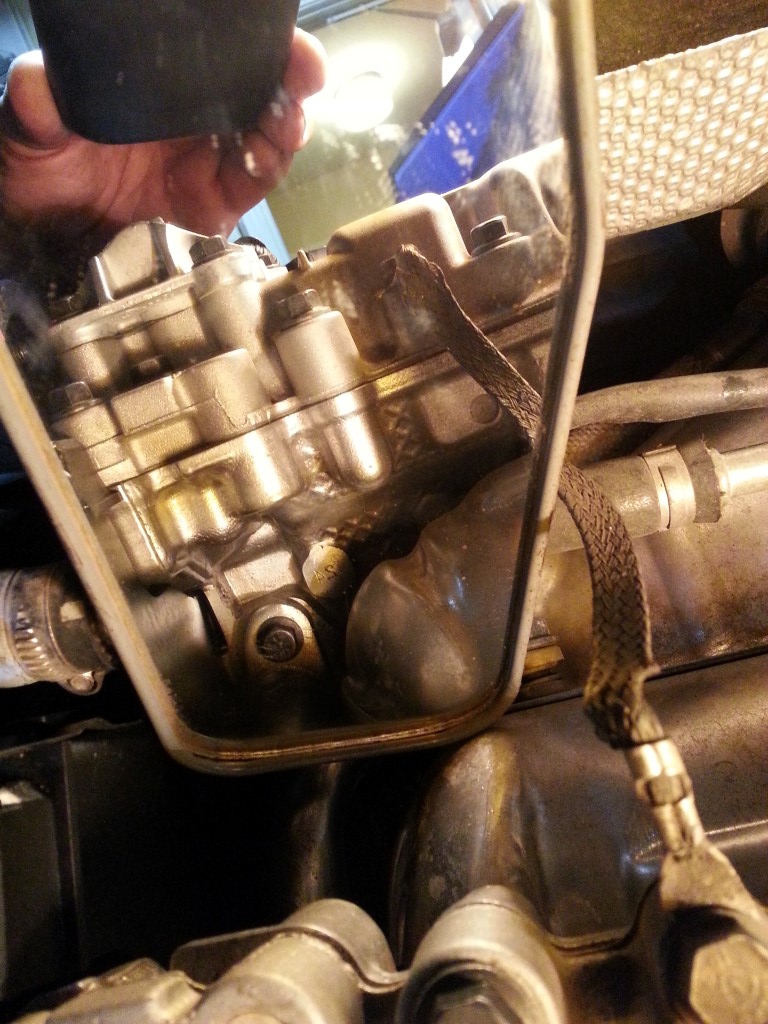
From above, photo of what I believe is a coolant line (the expansion tank routes into it) - thought what seems very strange is that it also routes to the turbo. I wasn't aware that coolant gets routed to the turbo - can someone confirm what that line is - coolant or oil ?
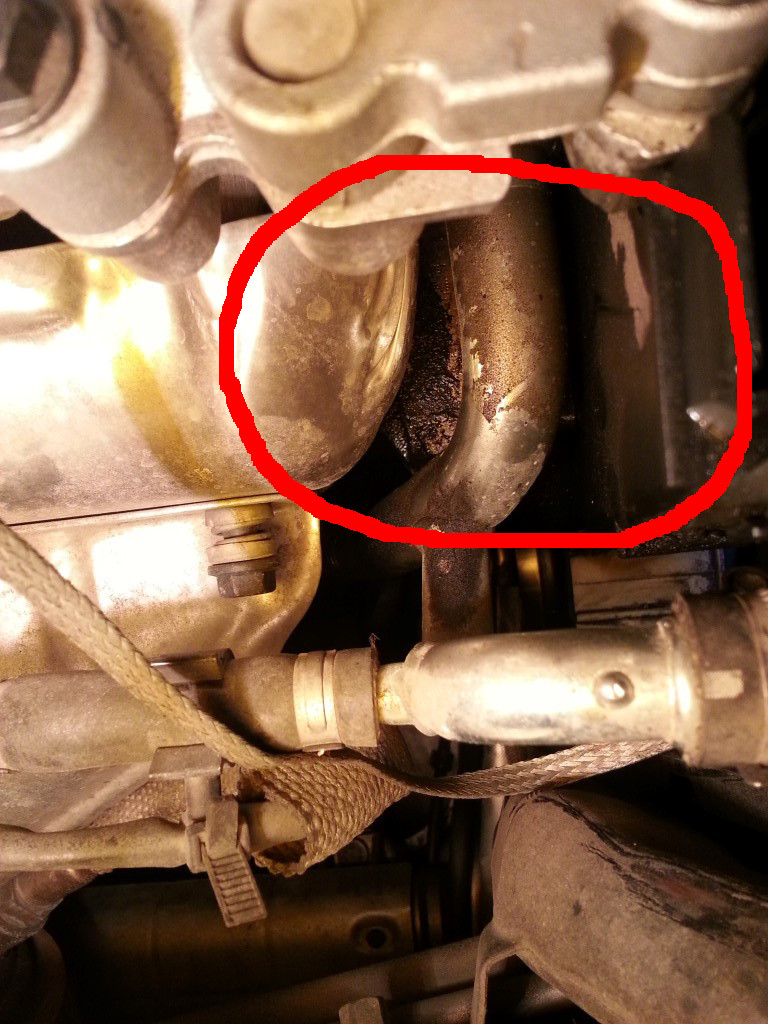
So, I have no idea what is causing the leak, still. The top of the water pump housing is clean and dry, it somehow only accumulates at the bottom. The camshaft seals are all new, CVVT o-rings have also been replaced. I also disconnected the exhast CVVT solenoid while I was running the engine - and oil still pooled on that ledge of the rear timing cover, just underneath the water pump.
At this point, I think there are three options.
1. The CVVT hub itself is leaking (not from the o-rings, but something internal). Will require that to be replaced.
2. The CVVT hub camshaft seal surface is worn out, and the camshaft seal isn't sealing right. The hub did look to have a slight groove where the seal rubs on it, I cleaned it some with emery cloth, but it still was noticeable as a tiny groove in the surface.
3. The leak is from something else. Read a few posts saying that the head gasket can actually leak, in exactly the area above the water pump. Anyone else heard about head gasket leaking?
Any advice on how to trace the leak 100% ? The visibility as you can imagine is not very good in that tight space. I tried using an inspection camera too, and I just can't see it. There is nothing conclusive about where exactly it is coming from. Any experience/acvice on using UV tracer fluid in the oil, is that likely to help?
cheers,
Jordan
New parts (two new seals, and the cvvt o-ring sets from ebay) arrived today.
I put it all together. As expected, I had put in the seals too deep when I did them first. When looking at the seal seat, the aluminium is colored differently where it has not been in contact with a seal, it has brown oil deposits. So, the seals do NOT go all the way in.

Car ran fine when I started it up (after turning the engine over by hand a few times, just in case), but soon after the CEL came on. I plugged VIDA in, and it indicated that the timing on the intake cam was 'low', meaning 'behind the crankshaft'. I must have not gotten the marks perfect when I installed the intake, for whatever reason. The good news is that I was able to compensate and adjust by loosening the 3 bolts that hold the CVVT hub to the timing gear. From the factory, the bolts were WAY over to one side of the oval holes, and I needed to bring the cam 'forward' so it catches up with the crank (as per the VIDA description), so I moved it a little, the bolts ended up basically in the middle of the oval holes. Cleared the code, no more CEL. Test drive was fine, no issues. Tested the PCV one more time just in case - vacuum in the crank case both at idle, and under boost.
Now, for the bad news. The slow leak does NOT seem to have been resolved. I had wiped everything clean, and then after I had run the engine for a while - there was new oil inside the timing cover. There appears to be a tiny amount on the timing gears themselves, though I can't be 100% certain. There is definitely new oil inside the rear timing cover, and in particular - it seems to collect on a little ledge right below the water pump. It collects in the areas highlighted in the following photos:



The water pump itself has some on it too, I had wiped it clean too.

Photo of my old water pump before the timing belt and water pump replacement, for reference:

A few more photos of the top camshaft area, from the firewall side:

From above, photo of what I believe is a coolant line (the expansion tank routes into it) - thought what seems very strange is that it also routes to the turbo. I wasn't aware that coolant gets routed to the turbo - can someone confirm what that line is - coolant or oil ?

So, I have no idea what is causing the leak, still. The top of the water pump housing is clean and dry, it somehow only accumulates at the bottom. The camshaft seals are all new, CVVT o-rings have also been replaced. I also disconnected the exhast CVVT solenoid while I was running the engine - and oil still pooled on that ledge of the rear timing cover, just underneath the water pump.
At this point, I think there are three options.
1. The CVVT hub itself is leaking (not from the o-rings, but something internal). Will require that to be replaced.
2. The CVVT hub camshaft seal surface is worn out, and the camshaft seal isn't sealing right. The hub did look to have a slight groove where the seal rubs on it, I cleaned it some with emery cloth, but it still was noticeable as a tiny groove in the surface.
3. The leak is from something else. Read a few posts saying that the head gasket can actually leak, in exactly the area above the water pump. Anyone else heard about head gasket leaking?
Any advice on how to trace the leak 100% ? The visibility as you can imagine is not very good in that tight space. I tried using an inspection camera too, and I just can't see it. There is nothing conclusive about where exactly it is coming from. Any experience/acvice on using UV tracer fluid in the oil, is that likely to help?
cheers,
Jordan
#17
That is a coolant pipe that runs along the back of the engine to the turbo. The turbo gets coolant and oil.
At this point, tracer dye is your best bet. I have never seen a head gasket leak there and have only seen two or three ever leak externally. And all were on cars I suspected of overheating.
The dye might not help though. The only places you can have oil leaking from in the timing cover are the cam seals, oil pump (which would be rare) or head gasket (which would be even more rare). So if it shows dye coming from a cam seal, which has been replaced twice, it won't tell you why it continues to leak.
At this point, tracer dye is your best bet. I have never seen a head gasket leak there and have only seen two or three ever leak externally. And all were on cars I suspected of overheating.
The dye might not help though. The only places you can have oil leaking from in the timing cover are the cam seals, oil pump (which would be rare) or head gasket (which would be even more rare). So if it shows dye coming from a cam seal, which has been replaced twice, it won't tell you why it continues to leak.
#18
Couple thoughts:
1. When you removed the factory seal, what tool did you use?
Did you use a screwdriver and in the process nicked the sealing surface of the camshaft?
If so, then it is bad news b/c the fix is not simple.
In any rotating surfaces, whether it is camshaft, axle/transmission interface, or crankshaft, the machined surface is very very smooth even when you look under the microscope. A tiny scratch by a screwdriver will cause an oil leak.
This is why I mentioned that seal removal is very tricky, I usually use 2 small screws at dead center of the seal and gently pry it out.
New Seal installation is also important: make sure the rotating surface is smooth. A bit of emery cloth may help clean up gunk on the camshaft, but do not use coarse sandpaper.
Depth is also important like you said, the inner lip of seal needs to be where the factory lip used to sit. This is b/c the factory seal lip makes some kind of "depression" (so subtle we can't see it) in the camshaft surface after millions of revolutions over 100K miles.
2. The issue of residual oil giving you the impression of oil leak. After any seal job, clean old oil so you know any new leak is new.
So:
- Leave the Upper Timing Cover out for a few days for easy visual inspection.
- Spray a bit of Purple Cleaner behind the Inner Timing Cover. Give it 10 sec to work its way down, then spray (water bottle, no pressure washer) with some warm water to rinse it off.
- Then wipe everything dry and monitor the leak.
- After 1 week, you should know if there is any new leak or not.
I have had this experience with something else before (my 1998 BMW 528i oil filter housing gasket repair): after the fix, I still saw oil leaking. It turned out that there is some residual oil left behind. After wiping it dry, no more oil leak.
I am hoping that your situation is from residual oil.
1. When you removed the factory seal, what tool did you use?
Did you use a screwdriver and in the process nicked the sealing surface of the camshaft?
If so, then it is bad news b/c the fix is not simple.
In any rotating surfaces, whether it is camshaft, axle/transmission interface, or crankshaft, the machined surface is very very smooth even when you look under the microscope. A tiny scratch by a screwdriver will cause an oil leak.
This is why I mentioned that seal removal is very tricky, I usually use 2 small screws at dead center of the seal and gently pry it out.
New Seal installation is also important: make sure the rotating surface is smooth. A bit of emery cloth may help clean up gunk on the camshaft, but do not use coarse sandpaper.
Depth is also important like you said, the inner lip of seal needs to be where the factory lip used to sit. This is b/c the factory seal lip makes some kind of "depression" (so subtle we can't see it) in the camshaft surface after millions of revolutions over 100K miles.
2. The issue of residual oil giving you the impression of oil leak. After any seal job, clean old oil so you know any new leak is new.
So:
- Leave the Upper Timing Cover out for a few days for easy visual inspection.
- Spray a bit of Purple Cleaner behind the Inner Timing Cover. Give it 10 sec to work its way down, then spray (water bottle, no pressure washer) with some warm water to rinse it off.
- Then wipe everything dry and monitor the leak.
- After 1 week, you should know if there is any new leak or not.
I have had this experience with something else before (my 1998 BMW 528i oil filter housing gasket repair): after the fix, I still saw oil leaking. It turned out that there is some residual oil left behind. After wiping it dry, no more oil leak.
I am hoping that your situation is from residual oil.
#19

